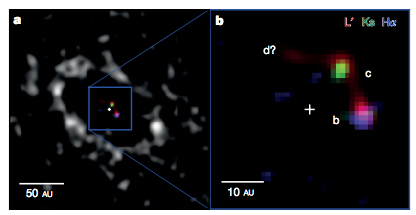My group is using the Large Binocular Telescope Interferometer (LBTI) and the Magellan Adaptive Optics system (MagAO) to image protoplanets around young stars. Using the technique of non-redundant masking, which turns filled-apertures into many-element interferometers, we probe spatial scales closer to the star than accessible to other techniques, and thereby focus on giant-planet-forming regions. This technique will eventually provide images with the resolution of the phased LBTI, equivalent to a 23-m telescope. Recent results are presented in these papers: Sallum et al. 2015 a, b; Eisner 2015.

Protoplanets observed within the cleared region of the disk aroud LkCa 15. Objects are detected at 2-4 micron wavelengths with non-redundant masking at the LBT. One source is also detected in H-alpha emission with Magellan AO observations.

Power spectrum of an astronomical source observed with a non-redundant mask in the LMIRCam instrument of LBTI. Note the central cluster of points, corresponding to baselines within each LBT aperture, and the extended clusters representing inter-aperture baselines out to 23 m.